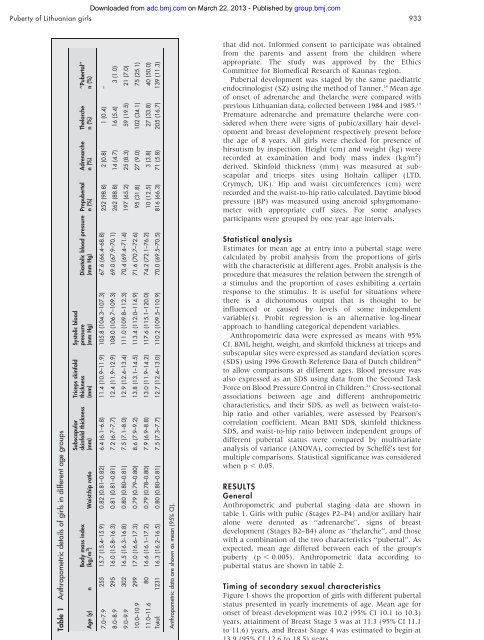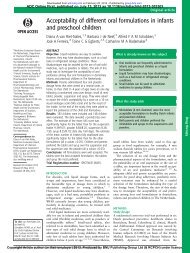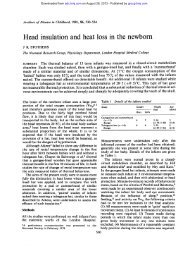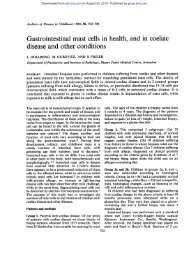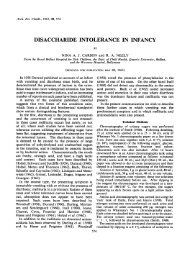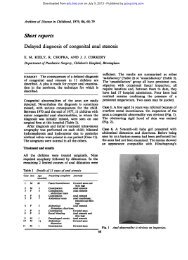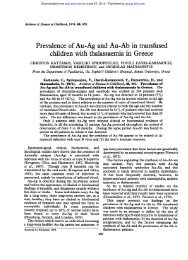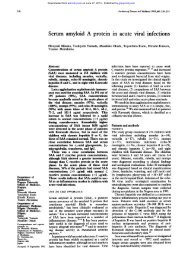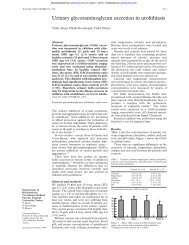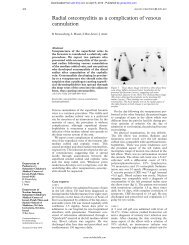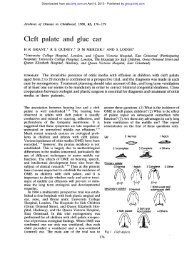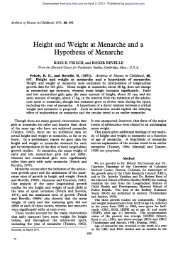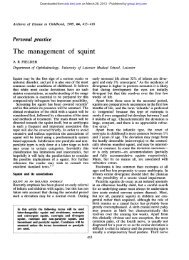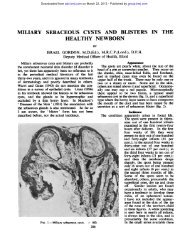Onset of breast and pubic hair development in - Archives of Disease ...
Onset of breast and pubic hair development in - Archives of Disease ...
Onset of breast and pubic hair development in - Archives of Disease ...
You also want an ePaper? Increase the reach of your titles
YUMPU automatically turns print PDFs into web optimized ePapers that Google loves.
Downloaded from<br />
adc.bmj.com on March 22, 2013 - Published by group.bmj.com<br />
Puberty <strong>of</strong> Lithuanian girls 933<br />
Table 1 Anthropometric details <strong>of</strong> girls <strong>in</strong> different age groups<br />
Subscapular Triceps sk<strong>in</strong>fold Systolic blood<br />
Body mass <strong>in</strong>dex<br />
sk<strong>in</strong>fold thickness thickness<br />
pressure Diastolic blood pressure Prepubertal Adrenarche Thelarche ‘‘Pubertal’’<br />
(kg/m Waist:hip ratio<br />
2 ) (mm) (mm) (mm Hg) (mm Hg) n (%) n (%) n (%) n (%)<br />
Age (y) n<br />
7.0–7.9 255 15.7 (15.4–15.9) 0.82 (0.81–0.82) 6.4 (6.1–6.8) 11.4 (10.9–11.9) 105.8 (104.3–107.3) 67.6 (66.4–68.8) 252 (98.8) 2 (0.8) 1 (0.4) –<br />
8.0–8.9 295 16.0 (15.8–16.3) 0.81 (0.81–0.81) 7.2 (6.7–7.7) 12.4 (11.9–12.9) 108.0 (106.7–109.3) 69.0 (67.9–70.1) 262 (88.8) 14 (4.7) 16 (5.4) 3 (1.0)<br />
9.0–9.9 302 16.5 (16.3–16.8) 0.80 (0.80–0.81) 7.5 (7.1–8.0) 12.9 (12.4–13.4) 111.0 (109.8–112.3) 70.4 (69.4–71.4) 197 (65.2) 25 (8.3) 59 (19.5) 21 (7.0)<br />
10.0–10.9 299 17.0 (16.6–17.3) 0.79 (0.79–0.80) 8.6 (7.9–9.2) 13.8 (13.1–14.5) 113.4 (112.0–114.9) 71.6 (70.7–72.6) 95 (31.8) 27 (9.0) 102 (34.1) 75 (25.1)<br />
11.0–11.6 80 16.6 (16.1–17.2) 0.79 (0.78–0.80) 7.9 (6.9–8.8) 13.0 (11.9–14.2) 117.6 (115.1–120.0) 74.2 (72.1–76.2) 10 (12.5) 3 (3.8) 27 (33.8) 40 (50.0)<br />
Total: 1231 16.3 (16.2–16.5) 0.80 (0.80–0.81) 7.5 (7.3–7.7) 12.7 (12.4–13.0) 110.2 (109.5–110.9) 70.0 (69.5–70.5) 816 (66.3) 71 (5.8) 205 (16.7) 139 (11.3)<br />
Anthropometric data are shown as mean (95% CI).<br />
that did not. Informed consent to participate was obta<strong>in</strong>ed<br />
from the parents <strong>and</strong> assent from the children where<br />
appropriate. The study was approved by the Ethics<br />
Committee for Biomedical Research <strong>of</strong> Kaunas region.<br />
Pubertal <strong>development</strong> was staged by the same paediatric<br />
endocr<strong>in</strong>ologist (SZ) us<strong>in</strong>g the method <strong>of</strong> Tanner. 18 Mean age<br />
<strong>of</strong> onset <strong>of</strong> adrenarche <strong>and</strong> thelarche were compared with<br />
previous Lithuanian data, collected between 1984 <strong>and</strong> 1985. 19<br />
Premature adrenarche <strong>and</strong> premature thelarche were considered<br />
when there were signs <strong>of</strong> <strong>pubic</strong>/axillary <strong>hair</strong> <strong>development</strong><br />
<strong>and</strong> <strong>breast</strong> <strong>development</strong> respectively present before<br />
the age <strong>of</strong> 8 years. All girls were checked for presence <strong>of</strong><br />
hirsutism by <strong>in</strong>spection. Height (cm) <strong>and</strong> weight (kg) were<br />
recorded at exam<strong>in</strong>ation <strong>and</strong> body mass <strong>in</strong>dex (kg/m 2 )<br />
derived. Sk<strong>in</strong>fold thickness (mm) was measured at subscapular<br />
<strong>and</strong> triceps sites us<strong>in</strong>g Holta<strong>in</strong> calliper (LTD,<br />
Crymych, UK). Hip <strong>and</strong> waist circumferences (cm) were<br />
recorded <strong>and</strong> the waist-to-hip ratio calculated. Daytime blood<br />
pressure (BP) was measured us<strong>in</strong>g aneroid sphygmomanometer<br />
with appropriate cuff sizes. For some analyses<br />
participants were grouped by one year age <strong>in</strong>tervals.<br />
Statistical analysis<br />
Estimates for mean age at entry <strong>in</strong>to a pubertal stage were<br />
calculated by probit analysis from the proportions <strong>of</strong> girls<br />
with the characteristic at different ages. Probit analysis is the<br />
procedure that measures the relation between the strength <strong>of</strong><br />
a stimulus <strong>and</strong> the proportion <strong>of</strong> cases exhibit<strong>in</strong>g a certa<strong>in</strong><br />
response to the stimulus. It is useful for situations where<br />
there is a dichotomous output that is thought to be<br />
<strong>in</strong>fluenced or caused by levels <strong>of</strong> some <strong>in</strong>dependent<br />
variable(s). Probit regression is an alternative log-l<strong>in</strong>ear<br />
approach to h<strong>and</strong>l<strong>in</strong>g categorical dependent variables.<br />
Anthropometric data were expressed as means with 95%<br />
CI. BMI, height, weight, <strong>and</strong> sk<strong>in</strong>fold thickness at triceps <strong>and</strong><br />
subscapular sites were expressed as st<strong>and</strong>ard deviation scores<br />
(SDS) us<strong>in</strong>g 1996 Growth Reference Data <strong>of</strong> Dutch children 20<br />
to allow comparisons at different ages. Blood pressure was<br />
also expressed as an SDS us<strong>in</strong>g data from the Second Task<br />
Force on Blood Pressure Control <strong>in</strong> Children. 21 Cross-sectional<br />
associations between age <strong>and</strong> different anthropometric<br />
characteristics, <strong>and</strong> their SDS, as well as between waist-tohip<br />
ratio <strong>and</strong> other variables, were assessed by Pearson’s<br />
correlation coefficient. Mean BMI SDS, sk<strong>in</strong>fold thickness<br />
SDS, <strong>and</strong> waist-to-hip ratio between <strong>in</strong>dependent groups <strong>of</strong><br />
different pubertal status were compared by multivariate<br />
analysis <strong>of</strong> variance (ANOVA), corrected by Scheffé’s test for<br />
multiple comparisons. Statistical significance was considered<br />
when p , 0.05.<br />
RESULTS<br />
General<br />
Anthropometric <strong>and</strong> pubertal stag<strong>in</strong>g data are shown <strong>in</strong><br />
table 1. Girls with <strong>pubic</strong> (Stages P2–P4) <strong>and</strong>/or axillary <strong>hair</strong><br />
alone were denoted as ‘‘adrenarche’’, signs <strong>of</strong> <strong>breast</strong><br />
<strong>development</strong> (Stages B2–B4) alone as ‘‘thelarche’’, <strong>and</strong> those<br />
with a comb<strong>in</strong>ation <strong>of</strong> the two characteristics ‘‘pubertal’’. As<br />
expected, mean age differed between each <strong>of</strong> the group’s<br />
puberty (p , 0.005). Anthropometric data accord<strong>in</strong>g to<br />
pubertal status are shown <strong>in</strong> table 2.<br />
Tim<strong>in</strong>g <strong>of</strong> secondary sexual characteristics<br />
Figure 1 shows the proportion <strong>of</strong> girls with different pubertal<br />
status presented <strong>in</strong> yearly <strong>in</strong>crements <strong>of</strong> age. Mean age for<br />
onset <strong>of</strong> <strong>breast</strong> <strong>development</strong> was 10.2 (95% CI 10.1 to 10.3)<br />
years, atta<strong>in</strong>ment <strong>of</strong> Breast Stage 3 was at 11.3 (95% CI 11.1<br />
to 11.6) years, <strong>and</strong> Breast Stage 4 was estimated to beg<strong>in</strong> at<br />
13.9 (95% CI 12.6 to 18.5) years.<br />
www.archdischild.com


